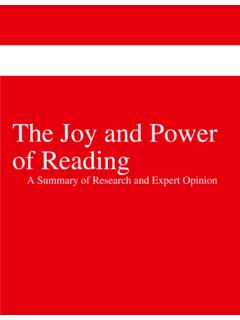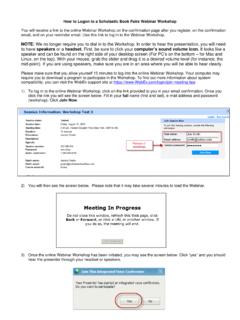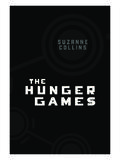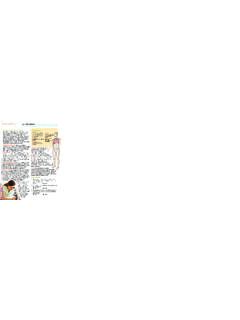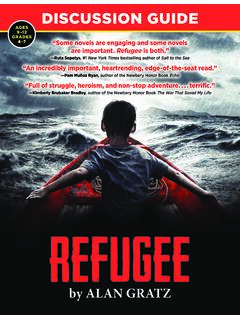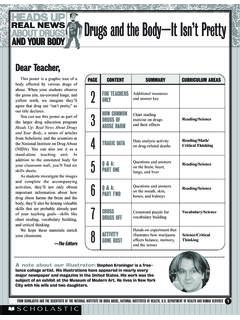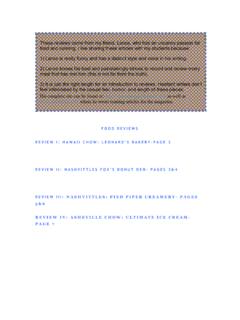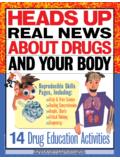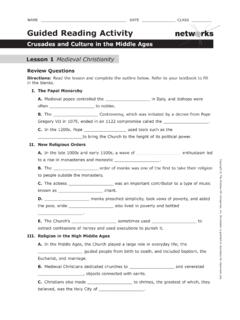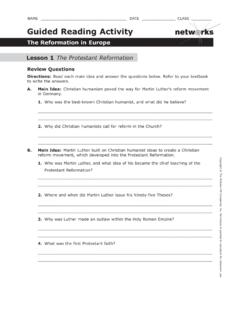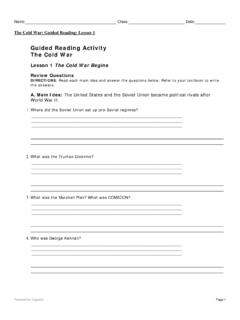Transcription of Guided Reading Indicators - Scholastic
1 Adapted from Fountas and Pinnell Continuum for Literacy Learning, 2007 Guided Reading Indicators Guided Reading Level A Descriptors Characteristics of Early Emergent Readers at Level A Simple factual texts, animal fantasy and realistic fiction Picture books Text and concepts highly supported by pictures One line of text on each page Familiar, easy content Repeating language patterns (3 6 words per page) Short, predictable sentences Almost all vocabulary familiar to children strongly sight word based Just beginning to learn how print works Just beginning to learn the alphabetic principle the relationship between letters and sounds Learning to use 1 1 matching Learning to follow text from left to right Differentiating between print and pictures Beginning to notice each letter s distinct features Learning some easy, high frequency words Guided Reading Level B Descriptors Characteristics of Early Emergent Readers at Level B Simple factual texts, animal fantasy and realistic fiction Simple.
2 One dimensional characters Picture books Text and concepts highly supported by pictures Two or more lines of text on each page Repeating language patterns (3 7 words per page) Very familiar themes and ideas Short, predictable sentences Almost all vocabulary familiar to children strongly sight word based Recognize and apply repeating language patterns Stronger awareness of left to right directionality Stronger awareness of 1 1 matching Learning concept of return sweep (moving from one line of text to the next) Able to distinguish and identify more letters according to their distinct features Developing stronger understanding of the connection between sounds and letters Expanding their core of easy, high frequency words Adapted from Fountas and Pinnell Continuum for Literacy Learning, 2007 Guided Reading Indicators Guided Reading Level C Descriptors Characteristics of Early Emergent Readers at Level C Simple factual texts, animal fantasy and realistic fiction Picture books Amusing one dimensional characters Familiar, easy content Introduction of dialogue (assigned by said in most cases)
3 Many sentences with prepositional phrases and adjectives Almost all vocabulary familiar to children greater range of high frequency words Some simple contractions and possessives (words with apostrophes) Two to five lines of text on each page Some bolded words Some ellipses, commas, quotation marks, question marks, and exclamation points Begin to move smoothly across the printed page when Reading Begin to use some expression when Reading Eyes are taking over the process of matching the spoken word to the printed word (removal of finger tracking) Developing phrased Reading Noticing dialogue and punctuation and reflecting this with the voice Developing a larger core of high frequency words Consistently monitoring Reading and cross checking one source of information against another.
4 Self correcting Adapted from Fountas and Pinnell Continuum for Literacy Learning, 2007 Guided Reading Indicators Guided Reading Level D Descriptors Characteristics of Early Emergent Readers at Level D Simple factual texts, animal fantasy and realistic fiction Picture books Amusing one dimensional characters Familiar, easy content, themes, and ideas Simple dialogue (some split dialogue) Many sentences with prepositional phrases and adjectives Some longer sentences (some with more than six words) Some simple contractions and possessives (words with apostrophes) Two to six lines of text on each page Some sentences turn over to the next line Some words with s and ing endings Fewer repetitive language patterns Eyes can track print over two to six lines per page Can process texts with fewer repeating language patterns Voice print match is smooth and automatic; finger pointing is rarely needed, if ever Notices and uses a range of punctuation and read dialogue, reflecting the meaning through phrasing Can solve many regular two syllable words, usually with inflectional endings ( ing).
5 Consistently monitors Reading and cross checks one source of information against another; self corrects Adapted from Fountas and Pinnell Continuum for Literacy Learning, 2007 Guided Reading Indicators Guided Reading Level E Descriptors Characteristics of Early Emergent Readers at Level E Simple informational texts, simple animal fantasy, realistic fiction, very simple retellings of traditional tales, simple plays Some texts with sequential information Familiar content that expands beyond home, neighborhood, and school Most concepts supported by pictures More literary stories and language Concrete, easy to understand ideas Some longer sentences more than ten words Some three syllable words Some sentences with verb preceding subject Variation of words to assign dialogue in some texts (said, cried, shouted) Easy contractions Mostly words with easy, predictable spelling patterns Two to eight lines of print per page Flexible enough to process texts with varied placement of print and a full range of punctuation Attend to more subtle ideas and complex stories Solve longer words with inflectional endings Read sentences that carry over 2 3 lines or over two pages Rely much more on the print.
6 Pictures are becoming less supportive Left to right directionality and voice print match are automatic Oral Reading demonstrates fluency and phrasing with appropriate stress on words Read without finger pointing, brining in finger only at point of difficulty Recognize a large number of high frequency words Easily solve words with regular letter sound relationships, as well as a few irregular words Adapted from Fountas and Pinnell Continuum for Literacy Learning, 2007 Guided Reading Indicators Guided Reading Level F Descriptors Characteristics of Early Emergent Readers at Level F Simple informational texts, simple animal fantasy, realistic fiction, very simple retellings of traditional tales, simple plays Some texts with sequential information Familiar content that expands beyond home, neighborhood, and school Both simple and split dialogue, speaker usually assigned Some longer stretches of dialogue Some longer sentences more than ten words with prepositional phrases, adjectives, and dialogue Variation in placement of subject, verb, adjectives, and adverbs Some compound sentences conjoined by and Many words with inflectional endings More details in the illustrations Most texts three to eight lines of text per page Periods, commas, quotation marks, exclamation points, question marks.
7 And ellipses Beginning to build knowledge of the characteristics of different genres of texts Read stretches of both simple and split dialogue Recognize a large number of high frequency words quickly and automatically Use letter sound information to take apart simple, regular words as well as some multisyllable words Process and understand text patterns that are particular to written language Beginning to read fiction with more well developed characters Left to right directionality and voice print match are completely automatic Read without pointing and with appropriate rate, phrasing, intonation, and stress Adapted from Fountas and Pinnell Continuum for Literacy Learning, 2007 Guided Reading Indicators Guided Reading Level G Descriptors Characteristics of Developing Readers at Level G Informational texts, simple animal fantasy, realistic fiction, traditional literature (folktales)
8 Some longer texts with repeating longer and more complex patterns Some unusual formats, such as questions followed by answers or letters Some texts with sequential information Familiar content that expands beyond home, neighborhood, and school Some texts with settings that are not typical of many children s experience Some sentences that are questions in simple sentences and in dialogue Sentences with clauses and embedded phrases Some complex letter sound relationships in words Some content specific words introduced, explained and illustrated in the text Complex illustrations depicting multiple ideas Most texts three to eight lines of print per page Slightly smaller print Able to internalize more and deeper knowledge of different genres Early Reading behaviors now completely automatic Recognize a large number of high frequency words Able to attend to more complex story lines and ideas Use a range of word solving strategies (letter sound information, making connections between words, using word parts)
9 To read unknown words Read texts with some content specific words Demonstrate appropriate rate, phrasing, intonation, and word stress Adapted from Fountas and Pinnell Continuum for Literacy Learning, 2007 Guided Reading Indicators Guided Reading Level H Descriptors Characteristics of Early Emergent Readers at Level H Informational texts, simple animal fantasy, realistic fiction, traditional literature (folktales) Narratives with more episodes and less repetition Accessible content that expands beyond home, school and neighborhood Multiple episodes taking place across time Some stretches of descriptive language Wide variety in words used to assign dialogue to speaker Some complex letter sound relationships in words Some complex spelling patterns Some easy compound words Most texts with no or only minimal illustrations Italics indicating unspoken thought Most texts three to eight lines of print per page Encounter more complex language and vocabulary Read longer.
10 More literary stories Able to process a great deal of dialogue and reflect it through appropriate word stress and phrasing Solve a large number of multi-syllable words, plurals, contractions, and possessives Able to read a larger and larger number of high frequency words Able to think at increasingly deeper levels Solve words with complex spelling patterns Begin to read more new texts silently, in order to achieve efficient and smooth processing Adapted from Fountas and Pinnell Continuum for Literacy Learning, 2007 Guided Reading Indicators Guided Reading Level I Descriptors Characteristics of Developing Readers at Level I Informational texts, simple animal fantasy, realistic fiction, traditional literature (folktales) Some informational texts with a table of contents and/or a glossary Narratives with multiple episodes and little repetition of similar episodes; more elaborated episodes Underlying organizational structures used and presented clearly (description, compare and contrast, problem and solution) Some unusual formats, such as letters or questions followed by answers Both familiar content and some new content children may not know Contain a few
